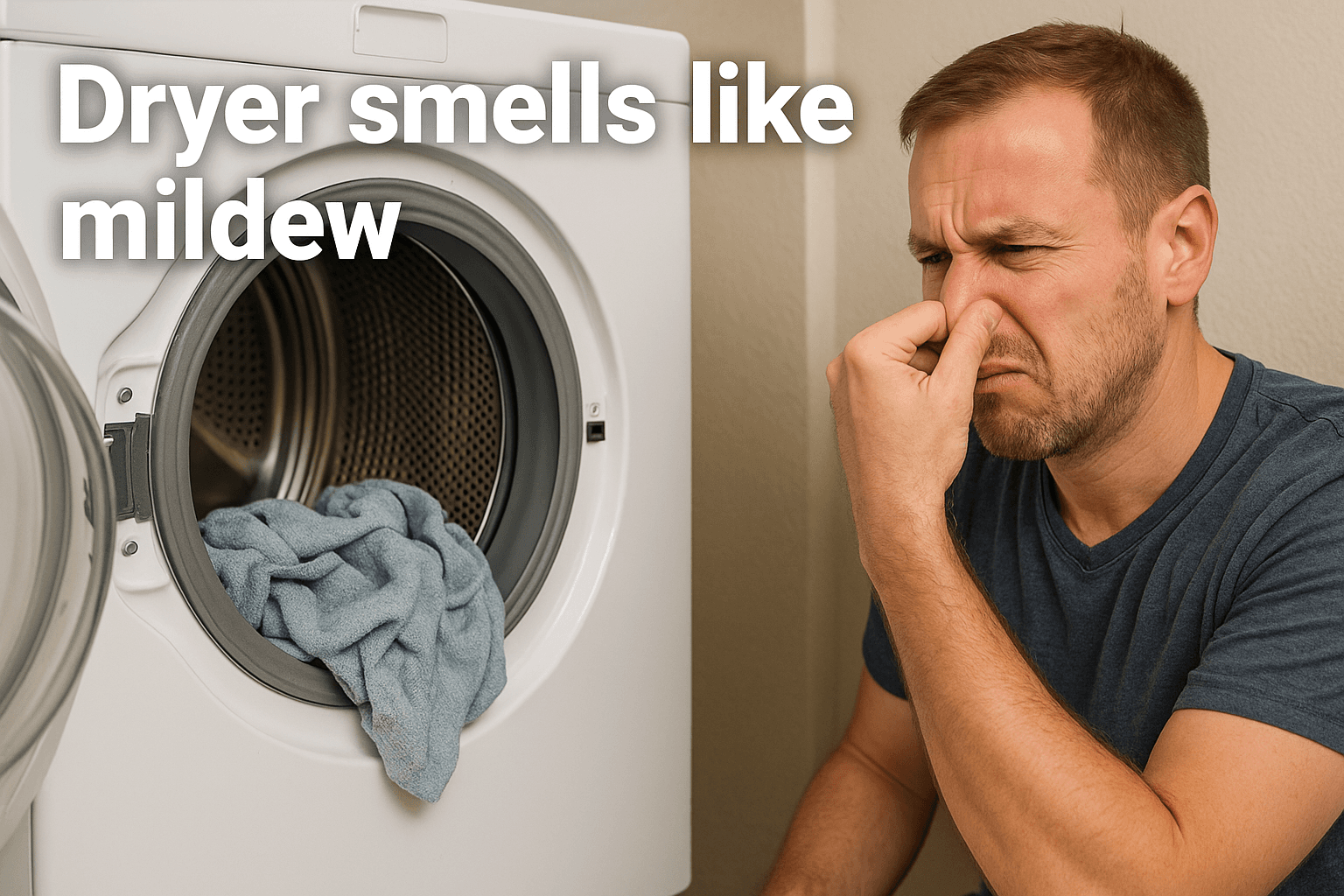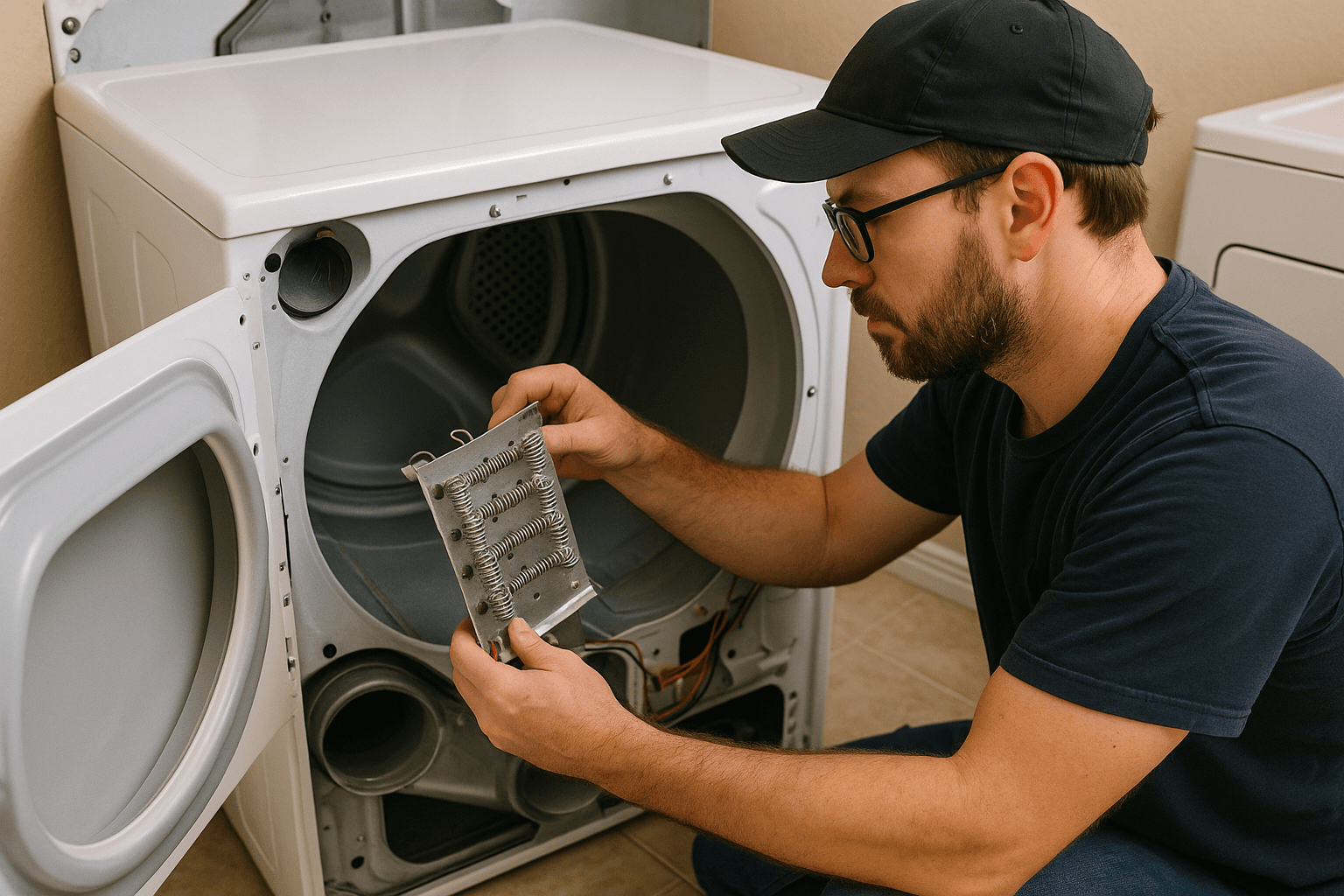Review
How Much Does Microwave Repair Cost? (Updated for 2025)
AZparts Team
Updated on July 30, 2025
8 min read
After a period of use, microwaves often develop issues such as not heating, the turntable not rotating, or failing to power on, leaving many people wondering whether it is worth repairing or better to buy a new one. In 2025, microwave repair costs can vary significantly depending on the type of malfunction, the model, and the parts that need replacement. In this article, AZParts will help you understand the latest repair cost estimates, the key factors that affect pricing, and offer practical tips to help you save money effectively.

1. Average Microwave Repair Costs (2025 Data)
As of 2025, the average cost to repair a microwave in the United States ranges from 100 to 250 USD, depending on the type of issue, severity of the damage, brand of the appliance, and local labor rates.
Item | Average Cost (USD) |
Overall repair cost | 100 – 250 |
Magnetron replacement | 100 – 300 |
Diode replacement | 80 – 170 |
Labor cost | 50 – 125 per hour |
Repair costs can vary based on the brand, type of microwave, age of the appliance, and whether the unit is still under warranty.
2. Factors That Affect Microwave Repair Costs
2.1. Brand and model of microwave
Brand has a major impact on repair costs. Premium brands such as Panasonic, Bosch, LG, and Samsung often use proprietary parts that are more difficult to find and more expensive. Additionally, the complex design of certain models like built in microwaves or those with integrated sensors and convection functions can make repairs more challenging and costly. In contrast, more common brands like Sharp, Midea, or Electrolux are generally more affordable to repair thanks to widely available and easy to replace components.
2.2. Type of repair needed
Each type of malfunction comes with a different price tag. Minor issues such as replacing light bulbs, fuses, or cleaning dirty internal parts usually have lower costs and can be handled quickly. On the other hand, problems involving the magnetron, control board, or transformer are more complex and expensive to fix, sometimes nearing the cost of a new microwave.
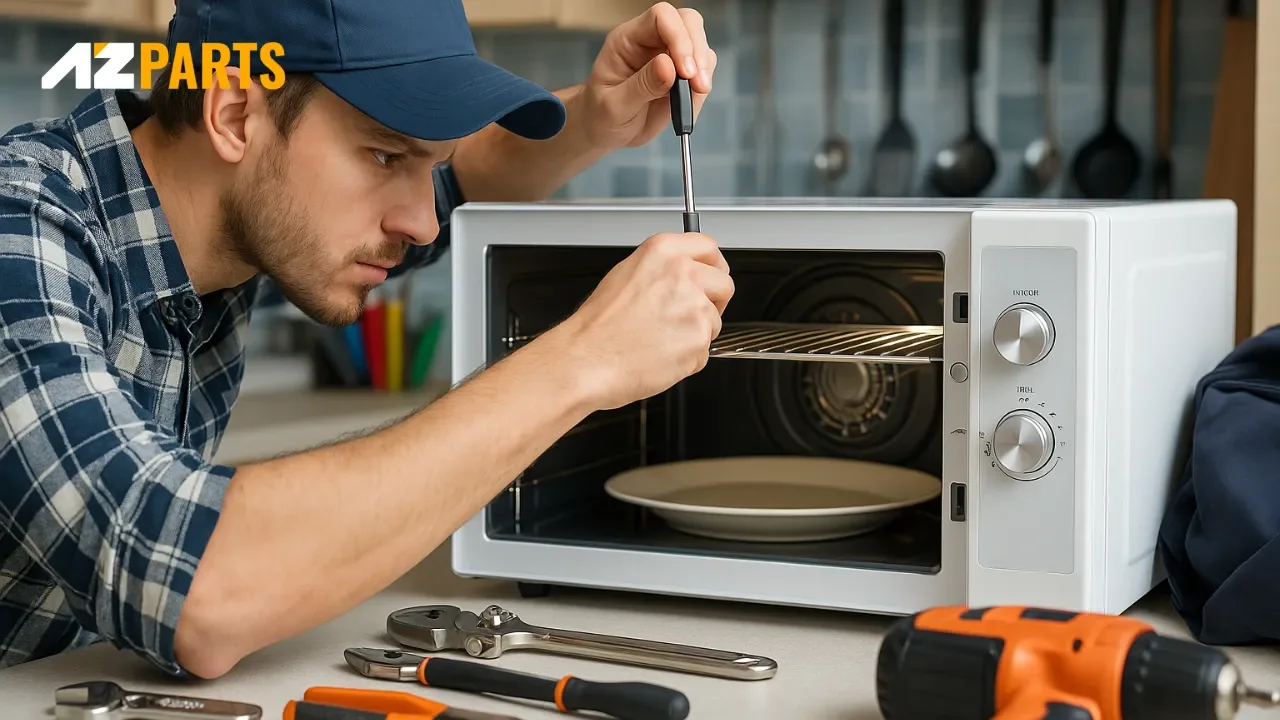
Each type of malfunction comes with a different price tag (Source: AZParts)
2.3. Microwave age and condition
The older the microwave, the higher the chance of part failure, and the harder it becomes to find replacement components. Older units may suffer from multiple simultaneous issues or internal corrosion, which can extend repair time. In some cases, a technician may recommend replacement instead of repair if the cost exceeds the remaining value of the unit.
2.4. Parts vs. labor cost
Not all expenses come from parts. In some cases, the effort required to access and diagnose the problem is what drives the cost up. Some parts may be inexpensive but located deep inside the machine, requiring almost full disassembly of the casing and electronics. In other cases, the part might be costly but easy to reach, meaning labor time and cost remain minimal.
2.5. Warranty status
If your microwave is still under the manufacturer warranty, you may be eligible for free repairs or only have to pay a small inspection fee. Additionally, if you purchased an extended protection plan from a retailer, many common issues could still be covered. However, if the warranty has expired and no coverage is in place, you will need to cover both parts and labor costs in full, which can make the total expense quite high.
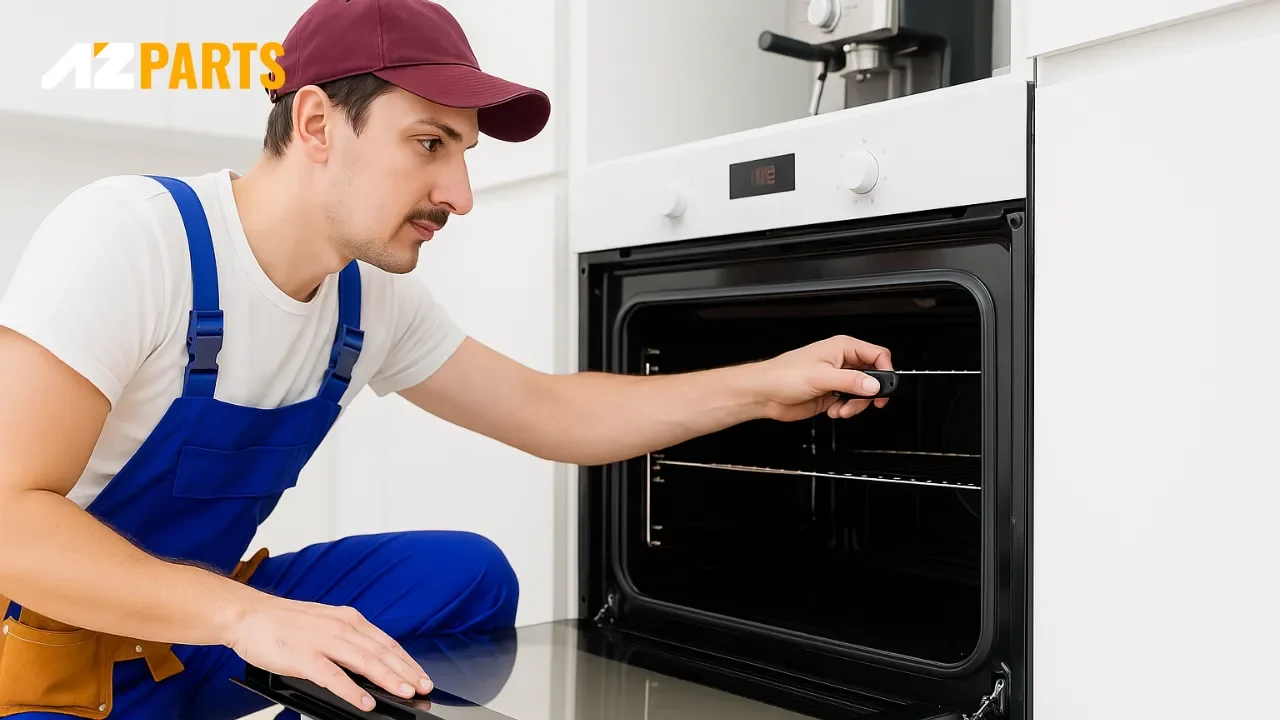
If your microwave is under warranty, repairs may be free or only require a small inspection fee (Source: AZParts)
3. Microwave Repair Prices by Type of Repair
Repair costs can vary depending on the part that is damaged and the complexity of the repair process. Commonly faulty components such as the magnetron, diode, control panel, or door switch all come with different price ranges. Below is a summary table of average repair costs for typical issues:
Type of Malfunction | Average Cost (USD) | Common Symptoms |
Magnetron | 100 – 300 | Not heating, loud noise, burning smell, black marks near the vent |
Diode | 80 – 170 | Sparking inside the microwave, not heating, unusual sounds |
Control Panel | 120 – 380 | Buttons not responding, auto on/off, light malfunctions, unit keeps running |
Turntable Motor | 90 – 200 | Turntable not rotating, strange noises |
Door Assembly | 170 – 330 | Door cannot open or close, cracked or jammed door |
Touchpad | 120 – 330 | No response, won’t turn on, continues running after timer ends |
8 – 65 | Won’t power on, stops suddenly, not heating | |
Microwave Door Oven Switch | 8 – 20 | Door won’t close properly, runs when door is open, no door signal detected |
Exhaust Fan | 130 – 330 | Loud noise, heat not venting, odor not filtered properly |
Light Bulb | 80 – 180 | No interior light during operation, control circuit malfunction |
Power Cord | 80 – 180 | No power, blown fuse due to faulty or unprotected cord |
Transformer | 100 – 300 | Not heating, sparking, sudden shutoff, smoke, burning smell |
Thermostat | 80 – 170 | Turns off immediately after powering on, exhaust fan not working |
4. Microwave Repair Costs by Type of Unit
Type of Unit | Average Cost (USD) | Notes |
Countertop Microwave | 100 – 200 | Simple structure, easy to disassemble, commonly available parts, lower repair costs. |
Built-in Microwave | 200 – 400+ | Must be removed from cabinetry, requires skilled labor, higher parts and labor costs. |
Convection Microwave | 250 – 450+ | Includes convection, sensors, and fan systems – complex design, more difficult to repair. |
Over-the-range Microwave | 200 – 350 | Requires careful removal, includes exhaust fan and lighting system, higher labor involvement. |
5. How to Save on Microwave Repair Costs
- Regular maintenance tips
Clean the microwave interior regularly to prevent grease and food residue buildup, which can cause electrical short circuits, sparking, or sensor malfunctions. Make sure the ventilation slots, exhaust fan, and air vents are not blocked by dust. Performing routine maintenance helps extend the appliance’s lifespan and reduces the risk of major failures.
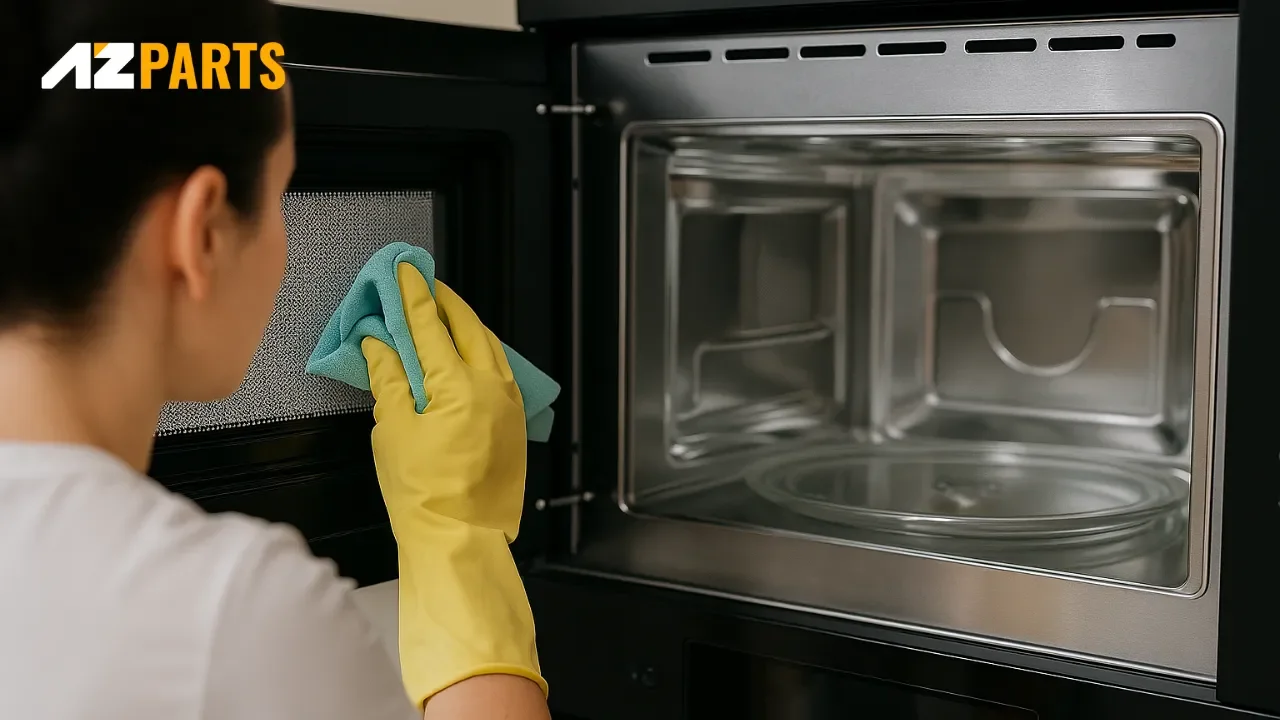
Regularly clean the interior to avoid grease buildup and electrical issues (Source: AZParts)
- Using warranty or extended protection plans
Before calling a repair technician, check whether your microwave is still under the manufacturer’s warranty. If you purchased the appliance from a major retailer and added an extended protection plan, many common issues may be covered at no extra cost or with only a small service fee. This can significantly reduce your overall repair expenses.
- Comparing repair service quotes
Before agreeing to any repair, contact at least two or three service providers to compare pricing and post-repair warranty policies. Some centers may charge high rates without offering reliable parts or reasonable warranty periods. Taking time to compare helps you find a trustworthy service at a fair cost.
- Fixing minor issues yourself
Simple problems such as no interior light, stuck buttons or a door that does not close properly can sometimes be fixed at home if you have basic technical knowledge. Check the manufacturer manual or follow tutorials from trusted sources to handle small issues safely and save on labor costs.

Fix simple issues yourself with basic know-how and trusted instructions (Source: AZParts)
6. Microwave Repair Cost FAQs
6.1. Is it worth fixing a microwave?
Yes but it depends on the age and severity of the issue. If the microwave is still relatively new under five years old and the damage is minor then repair is often more cost effective than buying a new one. However if the repair cost exceeds 50 to 60 percent of the original price or if the unit is very old, replacing it may be a better long term solution.
6.2. How expensive is it to fix a microwave?
Not necessarily. Common issues like replacing a fuse, a door switch or a light bulb usually cost between 75 and 180 USD. However if the repair involves major parts like the magnetron control board or transformer the cost can rise to 300 to 450 USD. Labor costs also play a role ranging from 50 to 125 USD per hour.
6.3. What is the average life of a microwave?
Most microwaves last between 7 and 10 years depending on build quality frequency of use and how well they are maintained. Higher end models or those that receive regular maintenance can last over 10 years. If the unit is near the end of its lifespan repairs may no longer be a cost effective option.
6.5. What is the common problem with a microwave?
Some of the most frequent issues include
- The microwave runs but does not heat usually due to a faulty magnetron or diode
- The unit does not power on often caused by a blown fuse or faulty door switch
- The turntable does not spin, strange noises, no interior light or an unresponsive keypad.
6.6 How much does a magnetron for a microwave cost?
Replacing the magnetron which generates the microwave energy to heat food typically costs between 100 and 300 USD including both parts and labor. This is one of the most expensive components in a microwave and often determines whether repair or replacement is the better option.
Repairing a microwave is a sensible choice if the appliance is still relatively new, the damage is not too severe and the repair cost is much lower than buying a new unit. In 2025 the average repair cost ranges from 100 to 250 USD depending on the type of issue, the brand and the model. However for major problems such as a faulty magnetron control board or transformer it is worth considering whether investing in a new microwave might be the better long term option.
To save on repair costs perform regular maintenance, make use of warranty coverage and address minor issues early. When replacement parts are needed choosing a trusted supplier is essential. You can refer to AZParts, a reputable provider of genuine microwave parts offering a wide selection and reasonable prices which helps make the repair process faster, safer and more cost effective. With the information provided we hope you now have a clear basis to decide whether to repair or replace your microwave.
Contact Info
Address: 8 The Green, Ste A, Dover, Delaware 19901-3618, United States
Email: support@azparts.com
Dryer
Further Reading
Further Reading


